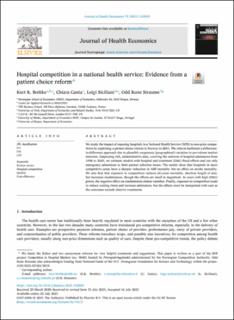Hospital Competition in a National Health Service: Evidence from a Patient Choice Reform
Journal article, Peer reviewed
Published version

Åpne
Permanent lenke
https://hdl.handle.net/11250/2990762Utgivelsesdato
2021Metadata
Vis full innførselSamlinger
- Department of Economics [289]
- Registrations from Cristin [9791]
Sammendrag
We study the impact of exposing hospitals in a National Health Service (NHS) to non-price competition by exploiting a patient choice reform in Norway in 2001. The reform facilitates a difference-in-difference approach due to plausibly exogenous (geographical) variation in pre-reform market structure. Employing rich, administrative data, covering the universe of hospital admissions from 1998 to 2005, we estimate models with hospital and treatment (DRG) fixed-effects and use only emergency admissions to limit patient selection issues. The results show that hospitals in more competitive areas have a sharper reduction in AMI mortality but no effect on stroke mortality. We also find that exposure to competition reduces all-cause mortality, shortens length of stay, but increases readmissions, though the effects are small in magnitude. In years with high (DRG) prices, the negative effect on readmissions almost vanishes. Finally, exposure to competition tends to reduce waiting times and increase admissions, but the effects must be interpreted with care as the outcomes include elective treatments.
